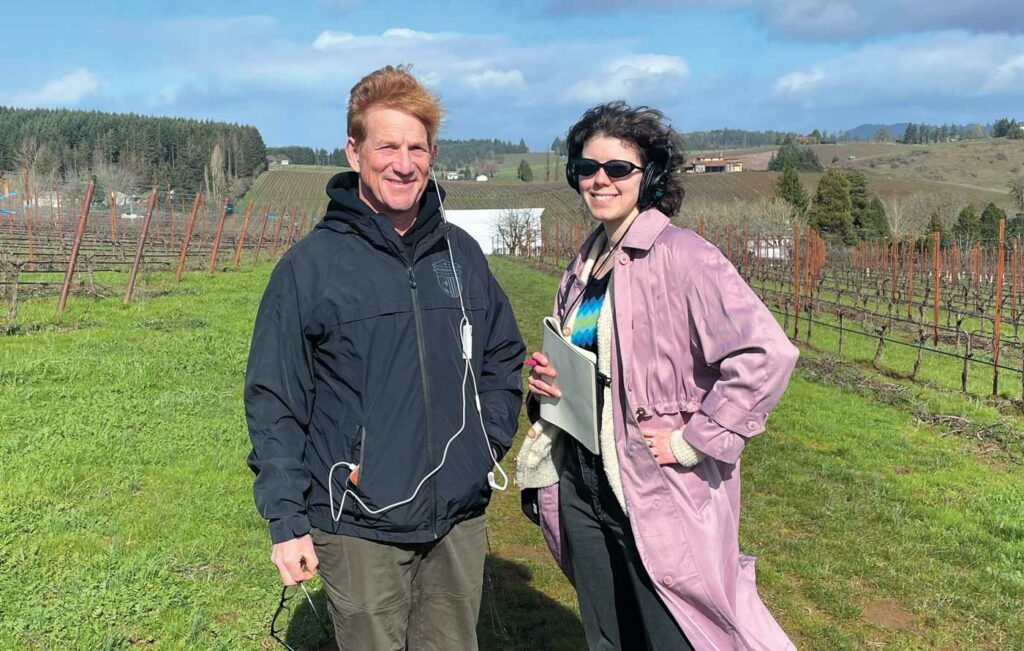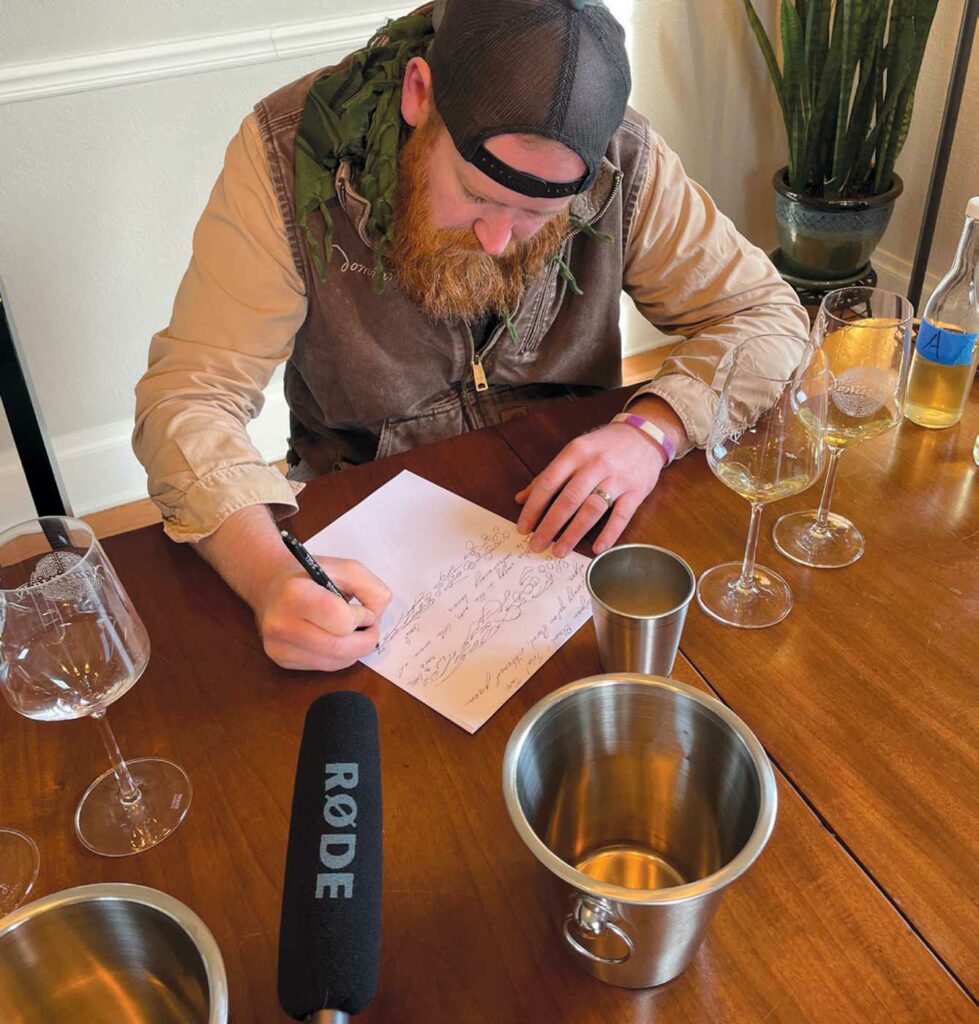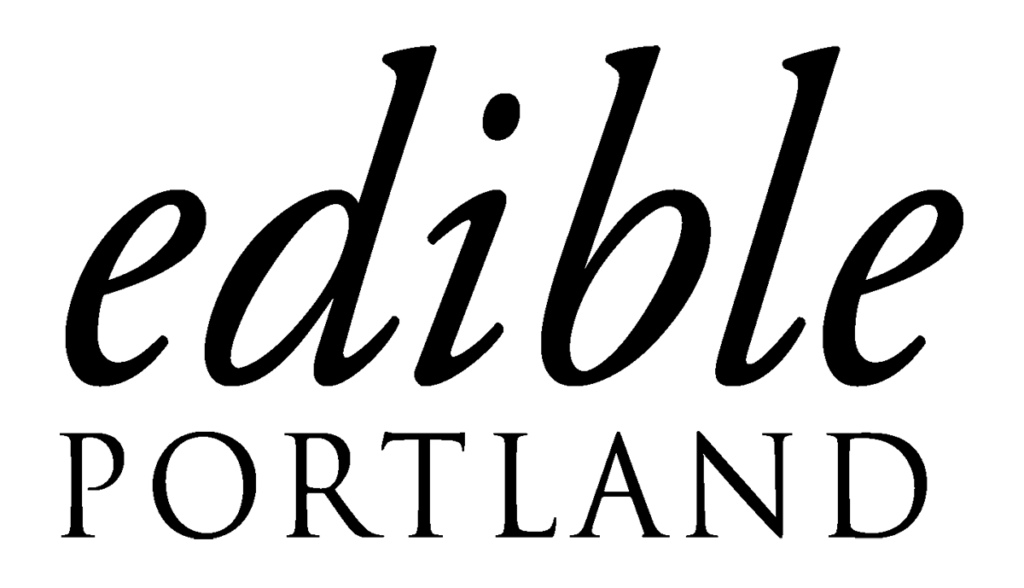
Documentarian Megan Hattie Stahl, 34, grew up in the heart of Oregon wine country, but she never set foot on a vineyard until two years ago. A student at Hunter College in New York City, Stahl was finishing her Masters of Fine Arts in “integrated media arts” (basically nonfiction media-making) when she went home to visit her family in McMinnville. She was struck by the Stoller Winery’s augmented reality room while researching potential wineries for a bachelorette party. “I’d been working in the new media space and doing sound walks for the past few years,” she says. “I thought: Why isn’t there an audio tour of a winery?”
She’d always known the wine industry was a big part of what made the Willamette Valley special, but since her family had no involvement in it, she’d always been a bit mystified by wine. She didn’t even drink the beverage at college. “I was more interested in craft beer,” she says.
It would be a way to use her skills as a documentarian and learn about wine in the process. She contacted Corey Guinee, a family friend and owner of the wine analytics company Core Enology. (She used to babysit Guinee’s kids.) She told him about her idea, and he immediately thought of his friend Patrick Reuter at Dominio IV Wines. Not only is Reuter an artist—for years, he’s been creating the “Shape Tasting” labels on his Imagination Series of wines, using shapes to convey taste—he’s also known for collaborating with other artists, breweries and even a distillery. (The farm also has hazelnuts, which the folks at Westward Whiskey came out and picked to use as a finish in their whiskeys.)
The next time Stahl was visiting her family in Oregon, she drove out to Reuter’s vineyard in the Yamhill-Carlton AVA, and the two sat down for a glass of wine and a spirited conversation about art, wine, sound, color and storytelling. They began bouncing ideas off one another as two creatives. At first, Stahl wanted to do an audio tour of the farm, a picturesque 82-acre property with a refurbished 1916 farmhouse. (There are indigenous artifacts on the property, like arrowheads, among other things.) However, Reuter thought it would be more compelling to document the making of a specific wine—from harvesting grapes in the vineyard to bottling and labeling. This is the idea they agreed upon.
Since making a white wine takes less time than making a red, they chose to follow a Sauvignon Blanc, a relatively new wine for Reuter. Thus was born “Sounds of Unknowing: The Making of an Oregon Sauvignon Blanc,” an almost 50-minute-long audio tour. The audio tour, which was released last August, is available on Dominio IV Wines website—bundled with two bottles of Dominio IV’s Sauvignon Blancs ($79). Last year, Sounds of Unknowing won a Signal Award for Best Experimental Branded Podcast.
Stahl starts the documentary in the vineyard, harvesting grapes alongside seasonal workers. She talks to Reuter and his wife, vineyard manager Leigh Bartholomew, about why they’re picking the grapes early—to capture that acidity and “gooseberry” flavor that Sauvignon Blanc is known for. In the background, you hear the shrieks and chirps of birds, Reuter’s Poodle-Labrador mix Smoochie Wallace chomping down on some grapes. Then she heads to the winery, where she interviews associate winemaker Ryan Kelly-Burnett as he’s pressing the grapes. Sixteen years ago, Kelly-Burnett came to Oregon for a “gap year,” and never left. He’s been working at Dominio IV Wines for 14 years now. In the winery, Stahl describes the barrels stacked to the ceiling—named after Wes Anderson movie characters—and discusses yeasts, fermentation, and barrel style with Reuter, Kelly-Burnett, and an exchange winemaker from Chile, Alfonso. Among other sounds, she captures the steady humming of carbon dioxide as it comes out of the bunghole of the barrel and the swooshing sound of topping off barrels. The documentary ends after the bottling of the wine in March, which is a team effort. (Even the young women from the tasting room help with the bottling.)
Stahl says she went from knowing practically nothing about the winemaking process to being an expert—at least on Sauvignon Blanc. “The thing about doing an audio project is that you spend hours listening to all the interviews and all of the information so now it’s very much drilled into my brain. So there are things I know about winemaking that I can never un-know.” Stahl is referencing Reuter’s name for the wine: The Path of the Unknowing, which for him meant that he wanted to “unknow” the things that he assumed about Sauvignon Blanc, turning the process of making it a journey of discovery.
One of her most significant discoveries during the 8 months of documentation was learning how hands-off the winemaking process is. “How much you are guiding rather than demanding of the wine,” she says. In the documentary, Kelly-Burnett says, “The #1 word in wine is: depends.” Stahl says she found a lot of parallels to her own creative process, where she comes in thinking she’s going to tell one kind of story, but then it goes in a different direction. “Winemaking is a creative process a lot more than I thought it was—on par with my creative process. Neither of us can control the product. It’s about intuition, choices, and adjustments and collaborating with the wine.”

Stahl’s favorite recording session was in Chapter 2: Fermentation, the first time she’s invited to join the winemakers for a barrel tasting. “It was very social,” Stahl says of the barrel tasting. “People are comparing their opinions and making decisions. I found this sense of family—intimacy and joy in sharing something together- charming.” The slurping and spitting sounds are especially evocative. This is when she learned that tasting wine at 11:00 a.m.—though it may sound like fun—is a lot of work. “You have to spit or you’ll lose a lot of focus,” cautions Kelly-Burnett. “Take another sip of your wine,” Stahl tells her audience. “Can you taste the toasted wood? The structure from the oak barrel?” Reflective moments like this allow the wine drinker to listen from home and experience the Dominio IV Sauvignon Blanc on a deeper level.
Bob Taylor, an at-home-winemaker in Washougal, Washington, says this was the first time he’s ever experienced an audio documentary of a winery—and he thoroughly enjoyed it. He liked that it covers the entire journey from the vineyard to the cellar and blending process. “I loved hearing from more of the people along the way—people in the field, in the winery—it pulled it all together in a more personal way,” Taylor says. He and his wife used to belong to many wine clubs but cut back during the pandemic. Dominio IV made the cut because it’s “quirky and interesting”—and they get to engage with Reuter. Says Taylor: “It’s not just another place that makes good pinot noir. Patrick is someone that thinks differently and is very experimental.”
Reuter says one of his favorite parts is in Chapter 3: The Blend, when Stahl includes a collage of wine descriptors that he and his fellow winemakers share at the end of a 10:00 a.m. blending session. The descriptors ricochet back and forth, rapid-fire: green apple, citrus flower, verbena, lemon peel, baked bread, tartness in the mid-palate, a little cloudy on the finish, shaved fennel, and so on. The staccato music you hear in the background of this session is composed by Stahl, who is also a classically trained piano player. Reuter admits that sometimes, blending sessions are so exhausting that he’ll go home and take a nap. “Your brain feels like a crystal,” he says.
Reuter says he loves the overall atmosphere that Stahl creates in the audio piece. “It sets you in the mood to drink wine,” Reuter says. “Sometimes you use wine as a social beverage. Other times, you really want to understand what’s going on. That quiet, studious environment she creates sets the stage for your perceptions.”
Next up, Stahl is working on a second audio project with Reuter: her original idea of doing a “sound walk” of the vineyard. Unlike Sounds of Unknowing, this one is meant to be listened to as you wander the vineyard. “It’ll be kind of like a loop,” says Stahl. It will include a trip up a hill for 360 views of the Coastal Range, Mount Pisgah, and several AVAs. In addition to covering viticulture and local geology, it will cover the land’s history—including indigenous histories and information about the pioneer families that lived at this particular farm.
Photos courtesy of Dominio IV Wines

